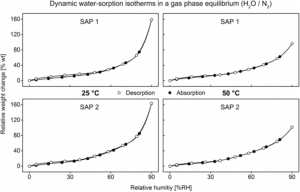A. Jung, M. B. Endres, O. Weichold
Polymers 2020
To the article→
Influence of Environmental Factors on the Swelling Capacities of Superabsorbent Polymers Used in Concrete
ABSTRACT: Superabsorbent polymers (SAP) are of major interest as materials to control the cement hydration process. The swelling behavior of the SAPs significantly influences the performance of the resulting concrete by slowly releasing polymer-bound water in order to maintain a consistent w/c value. A round-robin test conducted by the RILEM Technical Committee 260-RSC showed that the same batch of polymer can lead to large deviations in concrete performance and this was assumed to originate in di
erent storage conditions of the SAP. In this contribution the change in the performance of two SAPs, a crosslinked poly(acrylate) and a crosslinked poly(acrylate-co-acrylamide), was assessed after ageing in standard climate, at 50
°C, and under UV irradiation. During storage in standard climate or 50 °C, ageing led to dehydration of the SAP, and this subsequently led to a higher water uptake during swelling. By contrast, UV irradiation reduced the water uptake, most likely as a result of photo-crosslinking. Dynamic water vapor sorption experiments indicated a strong dependence of the water uptake on both the ambient humidity and the temperature. As a result, cement mixtures containing SAP must be calculated on the dry mass of the SAP rather than the actual weight on site. A standard procedure of how to pack and handle SAP to be used in concrete is also provided.

